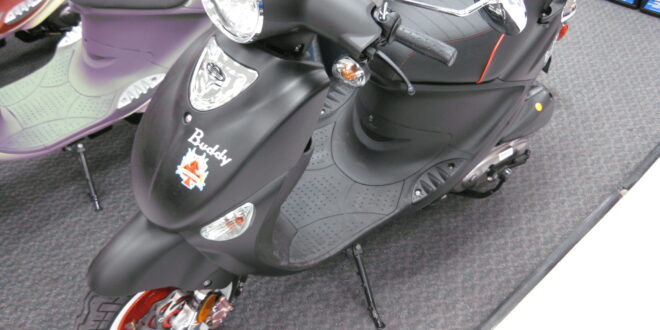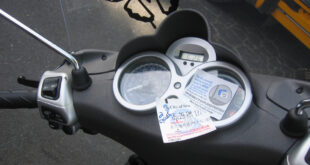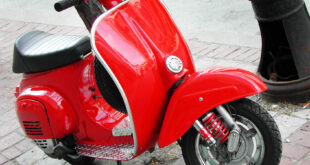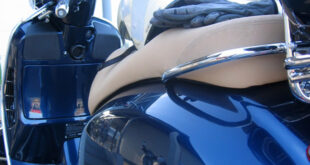50cc scooters are the entry level into the world of scooting. But is a 50cc scooter right for you? Avoid one of the biggest mistakes made by scooter newbies – buying a scooter that doesn’t have sufficient power for your needs. Here’s how to assess your needs fully so you can make an informed decision on the size of your new scoot.
Measuring Scooter Power
Scooter power is determined mainly by the engine displacement, which is measured in cc’s (cubic centimeters). The more cc’s you have, the more power you have. The more power you have, the faster you can go and the quicker you can get up to speed. More power also allows you to carry more weight, in human or cargo form.
As the engine power increases, so does the physical size and purchase price of the scooter. The majority of scooters on the road are between 50cc and 250cc, but a few models now come in 300cc, 500cc – or even more! These scooters on the high end of the cc range are often referred to as “maxi scooters.”
Maxi scooters aside, scooters are generally available in 50cc, 125cc, 150cc, 200cc and 250cc. There are a few oddballs out there, like the 80cc Honda Elite CH80 and the 300cc Vespa GTS. The 125cc scooter was less common until Genuine started making the popular 125cc Buddy.
How Much Power do YOU Need?
To decide how much power your scooter needs, ask yourself:
The more you weigh, the more power your scooter will need to carry you.
Will you be sticking to city streets, or do you want to be able to take the highway? Or will you traveling those routes in between?
Is it flat where you’ll be riding, or do you have lots of steep hills?
Will you eventually be carrying passengers? Do you plan to do a lot of grocery shopping? Camping? All cargo adds weight to your scooter, increasing the need for power.
After you’ve considered all the other factors, you still need enough power left to be able to quickly accelerate when necessary.
The Big 50cc Mistake
50cc scooters are the entry level into the world of scooting. If you’re lightweight and will be sticking to 25 m.p.h. city streets, a 50cc may do the trick. But getting a 50cc scooter because you don’t want to bother getting a cycle endorsement on your driver’s license is not a smart move.
You should get a 50cc scooter because you’ve assessed your needs and found that it meets them, not because the license endorsement is waived.
States vary in their licensing laws, but most require a cycle endorsement to operate a two-wheeled vehicle. Some states waive this requirement for scooters 50cc’s and under. This implies, incorrectly, that 50cc scooters are safer than 125cc scooters because they are slower, and therefore don’t require training to operate.
This is a dangerous fallacy. Most scooter collisions are not directly caused by speed – they are caused by oncoming vehicles turning in front of you at an intersection. This is true of 50cc scooters, 150cc scooters – and even 1200cc motorcycles.
Every rider should take the cycle safety course, regardless of the size of their scooter. Riding a scooter can be significantly more dangerous than driving a car because little mistakes can be deadly. There are no “fender benders” in the world of two-wheels.
The safety course will teach you how to avoid obstacles and stay as visible as possible to other vehicles. Assuming you pass the course, you’ll be awarded your cycle endorsement at the end of it anyway.
Take the safety course, whether or not it’s required.
Now that we’ve got that out of the way, let’s assess your needs.
Adequate Power Can Save Your Life
A scooter that provides you with adequate engine power is essential. How much power you need depends on you and your riding conditions. I may need 250cc, while 125cc may be more than enough for your circumstances. Your scooter should provide you with enough power to get you where you need to go, and to:
Keep up with the flow of traffic
Think about the speed limit of the roads you’re likely to travel on. You need to be able to keep up with the flow of traffic to ride safely. If you are riding significantly slower than the cars on the road, you increase your likelihood of being passed unsafely or being struck from behind.
Don’t forget that many of the cars around you will be traveling much faster than the speed limit. The fewer cars that pass you in your lane, the safer your trip is. Nothing is more terrifying than riding open-throttle, as fast as you can, with SUVs whizzing past you on either side.
Accelerate out of danger
A good rule of thumb: whatever roads you’re riding on should allow you to travel 10 m.p.h. under your scooter’s maximum speed. This leaves you enough accelerating power to dodge obstacles or zip out of the path of a vehicle.
I have been saved countless times by the pick-up power available to me on my 250cc scooter when a car changed lanes without seeing me and I was able to zip out of the way. Likewise for avoiding enormous potholes or litter in the road.
Adequate Power Can Increase Enjoyment
If you know you have enough oomph in your engine to keep up with the flow of traffic (including when you take a wrong turn and accidentally end up on a major artery), accelerate out of the way of danger, and deftly whisk you and your passenger up any hill your city throws at you, you will relax and enjoy the ride.
You will also have more fun if you choose to participate in group rides knowing you can keep up with everyone. Having a scooter with enough power to meet your needs is simply more enjoyable to ride.
Personally, I think 125cc is a good starting point for most people. Add more zip if you’re carrying passengers (150cc or more), and if you’ll be traveling on roads with speed limits of 45 – 50 m.p.h. If you want to get on the highway, you’ll need at least 200cc. On the highway with a passenger, 250cc.
But remember that larger engines are heavier and tend to come with physically bigger scooters, so keep those points in mind.
Also, I don’t recommend carrying passengers until you’ve had quite a bit of on-road experience.
How About an Example?
To give you an idea of how to assess your situation, here’s how I chose my scooter engine power.
My first scooter was an 80cc. I could carry a passenger, but there were spots along my normal routes when my friend had to dismount at the bottom of a hill and meet me at the top if I wanted to make it up. So when I decided to upgrade, I knew I needed at least 125cc’s (the next step up from an 80cc scooter).
First, I assessed my cargo load:
- I am six feet tall and I weigh 165 pounds
- I frequently carry passengers heavier than me
- I do grocery shopping and carry weighty items like bags of potting soil and cases of bottled water
This puts me at a minimum of 150cc.
Then I assessed the roads I travel on:
- I live in Seattle, where some of the hills are so steep there are stairs built into the sidewalks
- I travel on state routes with a speed limit of 50 m.p.h., so I need to keep up with traffic going at least that fast
- I participate in frequent group rides and want to be able to keep up with everyone without any trouble
Figuring these three points into my heavy cargo load, I could probably get by with 200cc. But I want enough power left over to accelerate out of danger and get on the Interstate if I have to. So my optimal engine size is a minimum of 250cc.
My Vespa GTS has a 250cc engine, and I use every cc of that with glee. I feel safe when riding that scooter and I don’t worry about keeping up with traffic. I can ride 2-up on the state routes and still have enough zip to keep me and my passenger out of the way of trouble.
Because I’m confident in the ability of my GTS to deliver when I need it most, I relax and enjoy the ride. That said, I’m looking forward to upgrading to the 300cc GTS soon!
I also have a 150cc Genuine Stella scooter that I only ride when I know I won’t be pressured to perform, and I keep off the freeways. Riding solo, the Stella’s maximum speed is 50 m.p.h. — with the throttle wide open, the wind at my back, riding in the direction of the Earth’s rotation.
My maximum speed riding 2-up on the Stella is about 45 m.p.h., and it takes us a looong time to get up to that speed. We’ll make it up that hill, you may just want to grab a cup of coffee while you wait for us. So I stick to roads with a speed limit of 40 m.p.h., which leaves me enough oomph to dodge a bullet should the need arise.
Give it some thought when deciding what size engine you need. If you choose wisely and get the scooter that meets your daily needs, you’ll be scooting safely and happily for a long time to come.
 Scooter Lust two wheels, one love
Scooter Lust two wheels, one love





One comment
Pingback: NS Recommends: Scooter Lust - Nathaniel Salzman